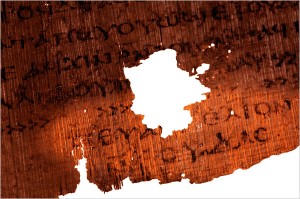According to William Johnson (pp. 87-91), the standard bookroll tended to have 20 sheets, though production of rolls with up to 50-70 sheets are known, but they are surely special orders. If a scribe ran out of space, he would simply glue a new blank roll on to the end of the used up one. This process continued until the copying was complete, and then the excess or blank remnant would simply be cut away. “A reinforced sheet, with fibres at right angles to the roll itself could (but need not) be added at the beginning, perhaps also at the end, to help prevent fraying.” (p. 91). The tools needed were papyrus, pen, ink, sponge, knife, glue. The standards of construction seem to have been exceedingly exact when it came to bookroll production. Johnson is able to demonstrate how across a wide sample size the normal column width, and the normal width of an intercolumn between the two columns on a page was remarkably standard across hundreds of papyri. This in turn suggests to him, I think rightly, that we are talking about professional scribes producing the vast majority of ancient documents that have survived, scribes who had professional training. We have had occasion to review another crucial book about ancient scribes on this blog, namely K. Van der Toorn’s Scribal Culture and the Making of the Hebrew Bible. (See the previous incarnation of this blog at Beliefnet).
What is clear enough to me is that the under-estimation of the importance of scribes and their roles in the production of NT documents is a big mistake especially when it comes to authorship issues. This mistake is one of the things that characterizes the recent work of Bart Ehrman on forgery and the NT. He does not take into account that often scribes would assemble documents out of oral and written memoirs of persons, sometimes even after they were dead, and attribute them not to themselves but to their source, or most important source. In such circumstances, modern notions of authorship should not be anachronistically applied to documents like 2 Peter, which is a composite document (involving portions of Jude, a Petrine source, and other sources of information) or say the Gospel of Matthew (assembled out of Mark, Q, and some special M material).
Here are some of my notes from the important latter part of Johnson’s book.
There is a definite difference between prose and poetic texts. Prose texts determinate at the right margin at a regular spot down the page, poetic lines do not.
Literary prose texts are more uniformly written in neat narrow columns than mundane documents, subliterary texts, or letters…. The tendency in any case was narrower columns earlier in the Roman period and wider ones by the third century.
p. 112 One interesting finding is that nicer volumes have wider intercolumns between the columns to go along with a fair hand, often majuscule.
p. 119 While width of a column varied not a great deal, the heighth of a column could vary enormously… from 10.8 to 29.3 cm with most between 12-27. Interestingly, when we are talking about verse in the Oxy. Papyri they tend to be 16cm… and below. Dramatic texts tend to be the shortest in column height whether tragedy or comedy. From A.D. 100 and before 63% of such texts tend to have a shorter column 16cm or less.
p. 122— By the second century AD elegant prose also tended towards shorter column height.
p. 124— In regard to lines per column it varies a lot from 18 to 64 as the extremes, and most between 25 and 50 with poetry and elegant prose tending to have less lines per column.
p. 125-26— There is a regular correlation between narrow width and shorter height.
p. 128— “In sum, the papyri show the following tendencies: 1) a short column is almost always narrow and a large percentage of short, narrow columns are also written in fine scripts; 2) a tall column is usually wide (and is rarely written in a fine script)…” during the Roman period.
p. 129 Almost all examples where the width of the column is more than the height in cms would have been striking to ancient readers and almost all such examples are written in fine scripts. By contrast, tall and thin columns are associated with inelegant mss.
p. 134 Margins are difficult to estimate since so few ancient papyri have their original dimensions at top and bottom due to wear and tear. In general, bottom margins tended to be a little bigger than top ones, but mostly these are 3-5 cms anyway at the bottom, and 3-4 cms at the top so not huge.
p. 135 It has been often asserted that finer mss. tended to have bigger margins… and this conclusion seems largely correct.
p. 136 “…the largest margins do in fact tend to associate themselves with better-written manuscripts.”
p. 140 Shorter columns tend to prefer larger margins and taller columns prefer smaller margins. There is no basis for the assumption that finer mss. tend to be written on taller rolls. “…finer mss with short columns and large margins, resulting in rolls of unexceptional height.”
p. 141—Normal height of a roll seems to have varied between 25-33 cm for the most part in the Roman period.
p. 143-44—The length of a bookroll seems to have tended to depend on the length of the document copied— if a letter, then short, if a longish book like Homer, then long, sometimes involving several rolls. There’s not a lot of evidence of combining several substantial books into one lengthy roll, but there are examples of a collection of Demosthenes’ Phillipic speeches on a single roll. Multiple short prose works in a single role do exist in the 3rd century examples. Unlike with speeches, we do not find multiple plays on a single roll but you do find this with later codices.
As for length of the roll it varied between 3 meters and upwards of 11 meters. There is even one that is 23m long.
p. 146— “by far the majority of the longest examples are written in very fine scripts. Could it not be the case that longer works or books were sometimes subdivided, so as, for example, to accommodate the ample format of a deluxe copy…’book’ and ‘bookroll’ are only usually and not uniformly coextensive” When a book went on too long, a separate roll would be used. See Orosius (5th century A.D.) the end of his second book.
pp. 148-50— The full Illiad would require 19 meters in length with 108 columns. But rolls above 15m were abnormal and considered awkward and bulky it would appear. Kenyon thought 35 feet (10.7 m) was an upper limit, but he was wrong. The normal upper limit seems to have been closer to 15m with some examples exceeding that.
A roll of 15 meters would be about 9 cm rolled up. A 7.5 meter roll would roll up to a circumference of about the width of a soda pop can. A 20 meter roll would roll up into the size of a 2 liter container of Coke. For a scroll of 15 meters you would need 105 windings of the scroll! Obviously, the fatter the scroll gets the less windings needed so for example a scroll of 10 meters requires 85 windings. Again, in general a roll contained a single book, or a single volume of a larger work.
p. 151 Nothing in the data suggests a standard length roll. It would be as long as it needed to be, unless the size became too much, in which case another roll would be used. Nothing in the data suggests that a scribe regularly filled out a roll with other books or plays etc. though of course there are some rolls that have several speeches etc. Roll length was determined by knife. “That the roll length was not predetermined by a ‘standard’ would not seem to need such emphasis.”
See Pliny Ep. 120.4-5 for a preference for longer books… but also for a complaint about a roll too large to fit comfortably in the hands of a old person Ep. 2.1.4.
p. 152 Johnson moots the possibility that short books of Greek romantic novels were deliberately slim so as to match the look and feel of love poetry, and books of history were deliberately fat, so as to suggest the weightiness of the enterprise. When it comes to prose however the hard evidence does not suggest that scribes tended to treat different genre of prose works differently when it came to line length etc.
p. 155 Philosophical texts from Egypt did tend to conform to a particular set of conventions including being unique in the use of dicolon and a tendency toward pre-defined letter counts and width to height groupings.
p. 156 A typical deluxe edition will not look different from an ordinary one except in the fineness of the script and often the largeness of the letters (and perhaps of the paper quality). Other features sometimes found in deluxe editions are wide margins, and so a short height for columns and an excessively long roll for a large book. In other words aesthetics to please a wealthy reader seem to be guiding this sort of decision making by the scribe.
p. 88– “As for bookrolls, there is no hint that the book began life in any way except as a roll.” If one was writing a one page document, one would cut a piece off a roll.
Interestingly, when the columns are laid out on a roll, no attention is paid at all to where there are glue joints.
Pliny the Elder NH 13.78 talks about papyrus and its various grades and qualities. Pliny rates it on width, thinness, denseness, smoothness, whiteness.
Papyrus grades by width
Macrocollum— 44.4 cm
Claudian (after reform)—- 29.6 cm
Optimae chartae—- 24.1cm
Hieratic— 20.4 cm
Fannian—-18.5 cm
Ampitheatric—- 16.7cm
Emporitic—- 11.1cm
( the Oxy. Papyri for this study varied between 21cm and 23.7cm)
p. 91— “The scribe then generally picked up a roll of high (not highest) quality for a bookroll, and, even though he was aware, perhaps acutely, of the sheet joins, he viewed the space available for his design in terms of a roll, that is, as a white space, bounded by height, but virtually unbounded by width.” It is mundane documents and subliterary texts that tend to be written on inferior rolls. Scribes were picky and in the early Roman era there was a strong preference for a slightly forward tilt to the letters, and the lack of any tilt was anathema.













